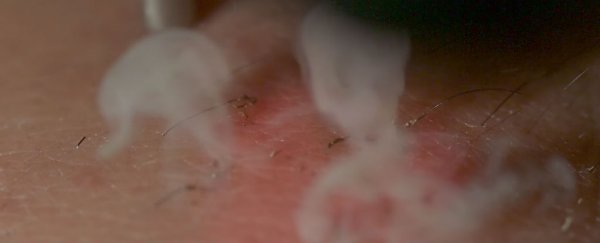It's been hailed as the most popular non-surgical cosmetic treatment in the world, and it's not hard to see why - permanent removal of unwanted body hair sounds almost too good to be true. But is it? Does laser hair removal really kill off hair follicles permanently, and how is that even possible? If you've ever considered undergoing the procedure, or you already have and are just wondering how the eff it even works, Veritasium and Physics Girl have teamed up to find out.
In the video above, we see Derek from Veritasium have a few hairs from his shoulder burnt to a crisp via a few ultra-fast bursts of a laser set to a wavelength of 1,064 nanometres. That puts it in the infrared radiation wavelength, which means the light emitted by the laser is invisible to the naked eye, so what we see is close-up and slowed-down footage of Derek's hairs looking progressively more dead over the course of a few milliseconds.
Next, the laser is turned up a notch, and we see those ill-fated shoulder hairs withstand (or not, as it turns out) a burst of 25 joules of energy per square centimetre of skin. As Derek points out, when you watch it all happen in slow motion, it looks like an O.K. Corral-style gunfight, with the tiny hair outlaws curling up to die.
So what's actually going on here?
You probably already know that dark eyes, skin, and hair contain a molecule called melanin, which absorbs a wide range of wavelengths of light, especially in the ultraviolet spectrum. That's important, because it allows melanin to act as a powerful shield against the Sun's harmful rays. Just got a sun tan? That's your body adding a protective layer of melanin to your skin in response to all that sun exposure.
What laser hair removal does is use the hair's melanin content against it. As Derek explains in the video above, it gets dark hairs to absorb the infrared laser light, which burns them to a crisp, without the skin around the hairs absorbing much energy at all.
Have you got really dark hairs and light skin? Congratulations, science says you're the best candidate for laser hair removal, because your hairs will absorb almost all the laser light, which therefore protects your skin. And that's a good thing, because that laser light ends up heating the hairs to well over 100 degrees Celsius (202 Fahrenheit), which is definitely not something you want your skin to feel.
But you can burn hairs to a crisp all day long - they're still going to grow back every time, right? Not like this. The laser bursts are so intense that they actually kill off the germ cells in the follicles that produce the hair in the first place. "It's kind of like using the hair to kill the hair," says Derek, knowing all too well how creepy that actually sounds.
So if you're interested in getting the procedure done, go for it - science has your back.
And if you can't get enough of sci-comm super-duo Veritasium and Physics Girl, or if you just really love learning about lasers (high fives!), check out the video below, where Physics Girl takes the reigns to explain how lasers can not only heat hairs to more than 100 degrees, they can actually cool things down.
